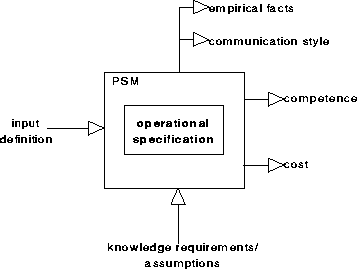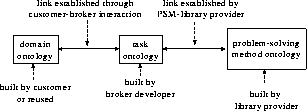
1University of Karlsruhe, Institute AIFB, 76128 Karlsruhe,
Germany, {dfe,studer}@aifb.uni-karlsruhe.de
2Knowledge Media Institute, The Open University, Walton Hall,
Milton Keynes, United Kingdom, {E.Motta,Z.Zdrahal}@open.ac.uk
3Dept. of Social Science Informatics (SWI), University of Amsterdam,
Roetersstraat 15, 1018 WB Amsterdam, The Netherlands, {richard,schreiber,wielinga}@swi.psy.uva.nl
4Artificial Intelligence Research Institute (IIIA), Spanish
Council for Scientific Research (CSIC), Campus UAB, 08193 Bellaterra, Barcelona,
Spain, enric@iiia.csic.es
The World-Wide Web is changing the nature of software development to a distributive plug & play process. This requires a new way of managing software by so-called intelligent software brokers. The aim of the European IBROW3 project is to develop an intelligent brokering service that enables third party knowledge-component reuse through the World-Wide Web. Suppliers provide libraries of knowledge components adhering to some standard, and customers can consult these libraries -- through intelligent brokers -- to configure a knowledge system suited to their needs by selection and adaptation. IBROW3 integrates research on heterogeneous databases, interoperability and web technology with knowledge-system technology and ontologies. The aim is to develop a broker that can handle web requests for classes of knowledge system (e.g. diagnostic systems) by accessing libraries of reusable problem-solving methods on the Web, and selecting, adapting and configuring these methods in accordance with the domain at hand.
The aim of this paper is to give a general overview of the project and to presents its main ideas and approach. IBROW3 has started on January 1, 1998 and thus we can only present preliminary results.
The World-Wide Web has the potential to change the nature of software development to a distributive plug & play process. This requires a new way of managing software by so-called intelligent software brokers Decker et al., 1997, Fensel, 1997a, Fensel et al., 1998.
The aim of the IBROW3 project is to develop an intelligent brokering service that enables third party knowledge-component reuse through the World-Wide Web. Suppliers provide libraries of knowledge components adhering to some standard, and customers can consult these libraries -- through intelligent brokers -- to configure a knowledge system suited to their needs by selection and adaptation. A customer in this context is a person/company that wants to solve a reasoning problem, such as the design of a technical product; a supplier could be a commercial or non-commercial provider of knowledge components that implement reasoning components. The project, thus, aims at providing intelligent reasoning services on the Web, as opposed to the more common information services Wiederhold, 1996.
The knowledge components we want to reuse are problem-solving methods (PSMs) McDermott, 1988. Today, many PSM repositories exists at different locations Benjamins, 1993, Puppe, 1993, Breuker, 1994, ten Teije, 1997, Barros, L. Nunes de et al., 1997, Valente & Löckenhoff , 1993, Chandrasekaran, 1990, Motta & Zdrahal, 1996, but they are not accessible for outsiders nor are they compatible (interoperable). There are some proposals for standards for reuse in knowledge engineering Genesereth & Fikes, 1992, Schreiber et al., 1994b, and there are emerging standards in interoperability Orfali et al., 1996, JavaSoft, 1996. The objective is to investigate whether it is possible to combine and elaborate both technologies to enable scaling up software reuse to a world-wide level, using the Internet.
We think that reuse will play an essential role in industrial knowledge system development in the next century Neches et al., 1991. The current technical state-of-the-art in knowledge systems is that existing PSM libraries provide individually substantial support for engineering knowledge systems (see Speel & Aben, 1997 for an example in industry). However, there are two important outstanding problems that prohibit more widespread industrial take-up and employment of existing knowledge-system technology. First, the components (PSMs) of the libraries are not accessible for third parties who do not know the component's implementation language. Second, the PSMs of the existing libraries are implemented in heterogeneous languages, and therefore they cannot interoperate. In the database world, related work is being performed on interoperability of distributed databases using so-called mediators Wiederhold & Genesereth, 1997, Wiederhold, 1996.
The project opens a novel perspective on building knowledge systems. It shifts the focus from centralized development of knowledge systems to configuring them by means of distributed third party reusable components. In current commercial practice, a knowledge system is either developed by a company's inhouse R&D department, or by contracting a software company. Successful completion of IBROW3 could contribute to changing this practice and to make knowledge system technology applicable on a much larger scale, while at the same time reducing its costs. The approach also allows the rapid generation of knowledge systems for exploratory prototyping purposes. This would enable industries to quickly and accurately assess whether knowledge-system technology is useful for them. In essence, intelligent brokers cooperate with, and take away much of the burdens an engineer is confronted with in the construction process. Associated benefits include the following.
The global approach to achieve IBROW3's objectives decomposes the problem in different, but related, issues. The overall picture is illustrated in Figure 1. The intelligent broker handles requests for reasoners from various customers. Based on these requests, it accesses different libraries available on the Web and searches them for candidate PSMs, which are adapted and configured into a knowledge system for the customer.

As a first step, the project will develop a prototype intelligent broker that is able to select, configure and adapt PSMs for a test case, using a PSM library for design Motta & Zdrahal, 1996. The approach of IBROW3 divides the objectives into the research topics described below.
PSM-description language
For selecting PSMs from a library, the broker needs to reason about characteristics of PSMs, for example about their competence Akkermans et al., 1994, Van de Velde , 1988 and their requirements, aka assumptions Benjamins et al., 1996, Fensel & Benjamins, 1996, Benjamins & Pierret-Golbreich, 1996, Aamodt et al., 1992. But there might also be other characteristics relevant for selection, such as the cost of executing a PSM (in terms of execution time or required interaction with a human), its cooperation style (LIFO, LILO), empirical facts of the PSM (how often has it been selected and used successfully), etc. We will develop a PSM-description language for adequately capturing these characteristics: the Universal Problem-solving Method description Language (UPML). This language is independent of specific implementations of PSMs, as it is a meta-description defining the broker's view of the PSMs. In today's knowledge engineering research, there exist concrete proposals for many of the ingredients of such a language Schreiber et al., 1994a, Angele et al., 1996, Gennari et al., 1996 including the input and output descriptions of PSMs, the relation between their inputs and outputs, and their assumptions and domain requirements. Figure 2 illustrates the ingredients of PSM description language.

Figure 2 : The ingredients of a universal PSM description language.
The formal underpinning of the language are Abstract Data Types Wirsing, 1990. If we want to exchange our problem-solving methods with other groups, then we have to build a wrapper. A KIF wrapper (Knowledge Interchange Format) Gruber, 1993, Genesereth & Fikes, 1992 would be a good candidate because KIF is widely used and especially designed to serve as a standard interlingua.
Ontologies
An ontology is a shared and common understanding of some domain that can be communicated across people and computers Gruber, 1993, van Heijst et al., 1997, Gruber, 1993, Uschold & Gruninger, 1996. Ontologies can therefore be shared and reused among different applications Farquhar et al., 1997, which is one of the main reasons why ontologies are popular nowadays. Most existing ontologies are domain ontologies, reflecting the fact that they capture (domain) knowledge about the world independently of its use Guarino, 1995. However, one can also view the world from a ``reasoning'' (i.e. use) perspective Ikeda et al., 1997, Fensel et al., 1997, Chandrasekaran et al., 1998. For instance, if we are concerned with diagnosis, we will talk about ``hypotheses'', ``symptoms'' and ``observations''. We say that those terms belong to the task ontology of diagnosis. Similarly, we can view the world from a problem-solving point of view. For example, propose & revise sees the world in terms of ``states'', ``state transitions'', ``preferences'' and ``fixes'' Fensel et al., 1997. These terms are part of the method ontology (or PSM ontology) of the propose & revise PSM. Several tasks and PSM ontologies are available including ontologies for design Chandrasekaran, 1990, Motta & Zdrahal, 1996, diagnosis Benjamins, 1993, ten Teije, 1997, planning Barros, L. Nunes de et al., 1996, propose & revise Zdrahal & Motta, 1995, cover & differentiate Eshelman, 1988, which can be reused and shared. Ontologies form an essential part of the intelligence of the broker needed for selecting, adapting and configuring PSMs. The part of the reasoning process that is concerned with these ontologies is referred to as ``ontological reasoning''. Figure 3 illustrates the relations between the different ontologies.

Selecting PSMs
The PSM-description language offers the syntax in which to express the characteristics of the PSMs (e.g., competence and requirements). The broker ``speaks'' the PSM-description language and reason about it to select candidate PSMs for customer requests. Basicly, this is a matching process between a query of the broker (which originally came from the customer) and the characteristics of the PSMs. The first selection of relevant PSMs for the query considers the competence of the PSM. Several types of matches are possible between the query and the PSM Zaremski & Wing, 1997, two of which are:
Apart from the matching process, additional knowledge is needed to select suitable PSMs for the tasks of the customers (e.g. diagnosis, design) Fensel et al., 1997. Tasks and PSMs may use different terms which are respectively captured in task and method ontologies. Both task and method ontologies are expressed in the PSM-description language, and before the broker can match two expressions (one in the task ontology and one in the method ontology, the expressions have to be mapped onto each other. It is the responsibility of the library providers to link their method ontologies to task ontologies. The broker exploits then these links before it tries to match the expressions.
Usually, the quality of retrieval is evaluated by two parameters: recall and precision Salton & McGill, 1983. Recall gives the ratio between the number of relevant components retrieved and the total number of relevant components in the libraries considered. Precision gives the ratio between the number of relevant components retrieved and the number of retrieved components. If no components are retrieved at all, then either the query can be weakened or the component (the PSM) can be strengthened Benjamins et al., 1996.
Configuring PSMs
When the customer provides the broker with a request (formulated as a task to be realized), the broker has to select adequate PSMs to realize the task. In general, it will not be the case that there is one complete PSM that can be retrieved for this task. The broker thus might need to combine different PSMs that together solve the problem Benjamins, 1995, Puerta et al., 1992, Runkel & Birmingham, 1993, Klinker et al., 1991. One way of doing this is to decompose the task into subtasks and then look for PSMs to realize these subtasks, etc. Once the relevant PSMs are found, the same knowledge can then be used to compose the problem solver from the selected submethods. In order to do so, the broker needs knowledge about the particular task under consideration that tells him how to decompose tasks, how the subtasks relate to each other (e.g. data flow and control flow), whether PSMs for the subtasks are mutually exclusive or dependent, etc. Such knowledge is also captured in task ontologies Benjamins, 1993, besides the vocabulary of the task Ikeda et al., 1997. In IBROW3, we build on research in Knowledge Engineering that deals with the configuration of PSMs, which can be performed manually Puerta et al., 1992, Runkel & Birmingham, 1993 or semi-automatically Benjamins, 1995, Barros, L. Nunes de et al., 1997, ten Teije et al., 1996, ten Teije, 1997.
Adapting PSMs
Since PSMs are generic components, the problem solver that is configured out of them has to be adapted to the particular domain knowledge of a customer before we obtain a knowledge system Gennari et al., 1994. This adaptation process basically consists of relating the configured problem solver to the domain ontology (cf. adapters in Fensel, 1997b). That is, it has to be explicated how concepts used by the problem solver map onto domain concepts. Today, a huge repository of domain ontologies exists Farquhar et al., 1997, Fridman-Noy & Hafner, 1997, Guarino & Poli, 1995, and we will reuse one for the test case. The links between the configured problem solver and the domain ontologies are established through an interaction process between the broker and the customer.
Interoperability protocol
The project aims at component reuse in a heterogeneous environment, which means that components implemented in different languages will have to cooperate with each other. Interoperability is thus an important issue. We recall that the objective of the broker is to configure a knowledge system for a customer, in other words, the broker provides the user with a reasoning service. There are different possibilities as where to execute the configured knowledge system (the product), that is, how to provide the reasoning service.
In the distributed version, the configuration process and the actual execution are interleaved. It is the broker's expertise that determines at what moment to send messages to the libraries.
We will identify the interoperability requirements needed for the project and we will evaluate existing proposals, like CORBA Orfali et al., 1996 as an object broker architecture and JavaBeans JavaSoft, 1996 as a component architecture. Whereas CORBA and JavaBeans aim at components, IBROW3 deals with knowledge components. We will select an appropriate proposal (with identified deficiencies for dealing with knowledge components), adapt it to our requirements (yielding a first rudimentary version) and apply it to the components of the PSM libraries (see Gennari et al., 1996, for an example of how to use CORBA for PSMs).
PSMs play an important role in knowledge-system development based on reusable knowledge components Benjamins & Fensel, 1998. However, the current status of building knowledge systems is a centralized process involving domain experts, domain ontologies, PSM libraries and knowledge engineers. In the project described in this paper, we explore the situation of distributed reuse through customers, intelligent brokers and providers. Our hope is that the intelligent broker -- which resides on the WWW -- takes away much of the burden a knowledge engineer is nowadays faced with. This objective introduces new issues like distributed sharing and reuse, heterogeneous knowledge components, and other problems related to large-scale web-based reuse.
In the USA, a new DARPA project called High-Performance Knowledge Bases (HPKB) (1) has been started in the spring of 1997. There is a significant intersection between the objectives of HPKB and IBROW3, including scaling up knowledge-component reuse, interoperability, Internet.
IBROW3 is funded by the European Commission under Esprit, Open LTR, proposal number: 27169. The consortium consists of the Intelligent Systems Lab Amsterdam (ISLA) of the University of Amsterdam, the Netherlands; the Artificial Intelligence Research Institute (IIIA) of the Spanish Council for Scientific Research, Spain; the Knowledge Media Institute (KMI) of The Open University, United Kingdom; and the AIFB institute of the University of Karlsruhe, Germany. IBROW3 is endorsed by an industrial advisory committee whose current members are Daimler-Benz, Germany and the Artificial Intelligence Applications Institute (United Kingdom).
Richard Benjamins is supported by the Netherlands Computer Science Research Foundation with financial support from the Netherlands Organisation for Scientific Research (NWO), and by the European Commission through a Marie Curie Research Grant (TMR).